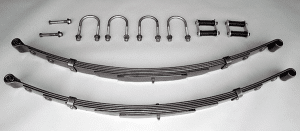Is It OK To Replace The Leaf Spring On One Side?
We strongly recommend that both leaf springs, either front or rear, be replaced at the same time.
The reason being is the older spring will be weaker, due to age and use, than the newer spring. This creates an imbalance where the newer spring supports more weight than the older spring, and chances are your vehicle will be higher on the side with new springs.
In other words, the vehicle will lean. Also, the new spring will be carrying a heavier load than the old spring and could fail before the older one does.
Should All Of The Vehicle’s Springs Be Replaced At Once?
While this may seem like a good idea, we do not recommend doing so unless both the front and rear springs are weak or broken.
It’s easy to tell if your springs are broken, but how do you tell if they are weak? Take a good look at the vehicle. Is it sitting low? Does it lean? If so, chances are the springs should be replaced.
Could My Vehicle Be Sitting Low Because The Shocks Are Bad?
If anyone ever tells you your ride is sitting low because the shocks are bad, get away from them as fast as possible and never take your vehicle to them for anything ever again.
The purpose of shock absorbers is to control the release of the springs’ kinetic energy. Or – stated more simply – shocks stop the springs from continuously bouncing up and down.
Stop and think…these hydraulic shocks can be compressed by hand. How could they hold up an entire vehicle? While gas shocks are a bit stronger, they are still not strong enough to hold up the weight of any vehicle.
When Replacing Leaf Springs, What Other Parts Should Be Replaced?
Any part that is used to attach the springs to the axle and frame should be replaced. et’s review the parts, starting at the front of the springs.
Eye Bolts
Most eye bolts will be rusted in to the spring’s eye bushings and may not survive their removal. Most springs come with the front eye bushing aready installed. For those that do not, get new bushings.
U-Bolts
Moving back, the spring is attached to the axle with U-bolts. The threads of most U-bolts are rolled, not cut, and when the nuts are torqued to the manufacturer’s specs, the threads become somewhat deformed.More damage is done to the threads when the nuts are removed. When trying to re-use old u-bolts, the depth of the threads are less than what they should be, therefore obtaining and maintaining the correct torque may be impossible.
Shackles
On the back-end of the springs is the shackle (well, on most vehicles). If the shackle bolts are available as seperate items, they should be replaced, because – just like the front eye bolts – chances are they will not be very good condition. If the bolts themselves cannot be replaced, get the complete shackle.
Frame and eye bushings should also be replaced. We provide complete Installation kits that have all required parts available for most vehicles.
What Is Rate, Load, and Load Rate?
These are terms that apply to all types of springs: leaf, coil, air, torsion – and they’re commonly misunderstood.
Spring Rate is the amount of weight required to deflect a springs an inch. The lower the rate, the softer the spring.
Load is simply the amount of weight on the spring.
Load Rate is the amount of weight a spring is designed to support at a certain height.
Too many people confuse spring rate and load rate. So a great way to impress your friends is to drop the correct usage in casual conversation.


